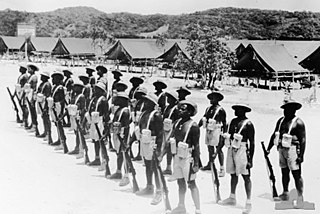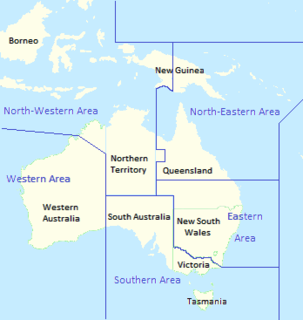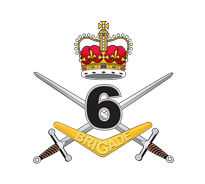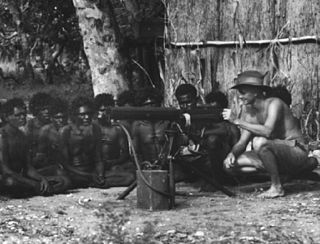
A long-range reconnaissance patrol, or LRRP, is a small, well-armed reconnaissance team that patrols deep in enemy-held territory.

The NORFORCE is an infantry regiment of the Australian Army Reserve. Formed in 1981, the regiment is one of three Regional Force Surveillance Units (RFSUs) employed in surveillance and reconnaissance of the remote areas of Northern Australia. It consists of a regimental headquarters, four surveillance squadrons, and an operational support squadron and training squadron.

The 51st Battalion, Far North Queensland Regiment is an Australian Army Regional Force Surveillance Unit headquartered at Porton Barracks in Cairns. The battalion's primary role is to conduct reconnaissance and surveillance tasks in support of border security operations. Its area of operations includes the Torres Strait and the Cape York littoral environment. Additional tasks for 51FNQR include the collection and collation of military geographic information as well as community engagement and disaster relief operations.
The name commando has been applied to a variety of Australian special forces and light infantry units that have been formed since 1941–42. The first Australian "commando" units were formed during the Second World War, where they mainly performed reconnaissance and long-range patrol roles during Australia's campaigns in New Guinea and Borneo, although other units such as M and Z Special Units performed more clandestine roles. These units were disbanded following the end of the war; however, in the 1950s it was realised that there was a need for such units again in the Australian forces. Today, the Australian Army possesses a number of units that perform more conventional direct-action type commando roles, as well as counter-terrorism response, long-range patrolling, and clandestine deep-penetration operations.
The Regional Force Surveillance Units (RFSUs) are specialised infantry units of the Australian Army Reserve responsible for patrolling northern Australia. Collectively, the RFSUs form the Regional Force Surveillance Group commanded by a Colonel based at the 2nd Division Headquarters in Sydney. The RFSUs conduct regular operational patrols during peacetime, and are composed primarily of Reservists who live within the area of operations. There are currently three battalion-sized RFSUs:

No. 18 Squadron was a joint Dutch and Australian bomber squadron of World War II. Formed in April 1942, the squadron was staffed by a mixture of Dutch and Australian personnel and placed under Royal Australian Air Force operational command. Initially it undertook anti-submarine patrols on the east coast of Australia, before moving to northern Australia and taking part in operations against the Japanese in the islands of the Netherlands East Indies (NEI). At the conclusion of hostilities, the squadron came under Dutch control and Australian personnel were transferred out. The squadron then undertook operations during the Indonesian National Revolution, before eventually being disbanded in July 1950 after being transferred to Indonesia.

The Torres Strait Light Infantry Battalion was an infantry battalion of the Australian Army during the Second World War. Initially raised as a company-sized unit in 1941, it was expanded to a full battalion in 1942 and was unique in that almost all of its enlisted men were Torres Strait Islanders, making the battalion the only Indigenous Australian battalion ever formed by the Australian Army. The battalion was used mainly in the garrison role, defending the islands of the Torres Strait, although in 1943 a detachment was sent to patrol Dutch New Guinea. Following the end of the war, the battalion was disbanded in 1946.

No. 13 Squadron is a Royal Australian Air Force (RAAF) squadron. The unit saw combat during World War II as a bomber and maritime patrol squadron and is currently active as a mixed regular and reserve RAAF unit located in Darwin, fulfilling both operational support and training duties.
William Edward Hanley "Bill" Stanner CMG, often cited as W.E.H. Stanner, was an Australian anthropologist who worked extensively with Indigenous Australians. Stanner had a varied career that also included journalism in the 1930s, military service in World War II, and political advice on colonial policy in Africa and the South Pacific in the post-war period.

No. 20 Squadron is a Royal Australian Air Force (RAAF) support squadron. Coming under the control of No. 96 Wing, it is responsible for the management of the airfield at RAAF Base Woomera, South Australia. The squadron originated as a maritime patrol unit during World War II. Raised in August 1941, it operated PBY Catalina and Short Empire flying boats from bases in New Guinea, Queensland and the Northern Territory, conducting search-and-rescue, mine-laying, anti-submarine and bombing missions against Japanese targets in the Pacific theatre. Following the conclusion of hostilities, the squadron was disbanded in March 1946. It was reactivated as an airfield support squadron in April 2015.

The 350th Electronic Systems Wing is an inactive United States Air Force organization. It was last active in 2010 as an electronic systems support unit located at Hanscom AFB, Massachusetts.

Northern Territory Force was an Australian Army force responsible for protecting the Northern Territory during World War II. Most units assigned to the Northern Territory Force were based near Darwin and were responsible for defending the important naval and air bases in and around the town against a feared Japanese invasion. Northern Territory Force was briefly renamed the 12th Division in late 1942 but this was short-lived. Australian Army units were rotated through northern Australia during the war and six infantry brigades served as part of Northern Territory Force between 1942 and 1945. The formation was reduced over the course of the war as the strategic situation in the Pacific turned in the Allies' favour, although remnants remained until the end of the war. In early 1946, it was converted back to the 7th Military District.

North-Eastern Area Command was one of several geographically based commands raised by the Royal Australian Air Force (RAAF) during World War II. For most of its existence it controlled units based in central and northern Queensland as well as Papua New Guinea. It was formed in January 1942 from the eastern part of the former Northern Area Command, which had covered all of northern Australia and Papua. Headquartered at Townsville, Queensland, North-Eastern Area Command's responsibilities included air defence, aerial reconnaissance and protection of the sea lanes within its territory. Its flying units, equipped with fighters, reconnaissance bombers, dive bombers and transports, took part in the battles of Rabaul, Port Moresby and Milne Bay in 1942, and the landings at Hollandia and Aitape in 1944.

No. 8 Squadron was an Australian flying training squadron of World War I and medium bomber squadron of World War II. The squadron was formed in England in October 1917 as part of the Australian Flying Corps, and disbanded in April 1919. It was re-formed by the Royal Australian Air Force in September 1939. After seeing action during the Pacific War flying Lockheed Hudson and, later, DAF Beaufort bombers, the squadron was disbanded a second time in January 1946.
A long-range penetration patrol, group, or force is a special operations unit capable of operating long distances behind enemy lines far away from direct contact with friendly forces as opposed to a Long Range Reconnaissance Patrol, a small group primarily engaged in scouting missions.
No. 268 Squadron RAF was a Second World War Royal Air Force squadron that operated the North American Mustang on missions over occupied Europe and in support of the D-Day landings.

The 6th Combat Support Brigade is an Australian Army brigade. First formed in 1912 as a Militia formation to provide training under the compulsory training scheme, the brigade was re-raised during the First World War as an infantry unit of the all volunteer Australian Imperial Force. It subsequently served at Gallipoli and in France and Belgium on the Western Front. In the 1920s, as part of a reorganisation of the Australian Army, it became part of the 3rd Military District of the Citizens Military Force, encompassing units from Victoria and South Australia. In 1991, it became part of the Ready Reserve Scheme, based at Enoggera Barracks, in Brisbane, Queensland, before being disbanded in 1996 when the scheme was discontinued. The brigade was re-raised on 1 March 2010 to oversee the Army's command support and intelligence, surveillance, target acquisition and reconnaissance units.

The Northern Territory Special Reconnaissance Unit (NTSRU) was an irregular warfare unit of the Australian Army during World War II, composed mainly of Aboriginal people from the Northern Territory. Formed in 1941, the unit patrolled the coast of Arnhem Land during 1942–43 searching for signs of Japanese landings and trained to fight as guerrillas using traditional weapons in the event of an invasion. In 1943, as the war moved northward from the Australian coast, the NTSRU was disbanded.

Western Area Command was one of several geographically based commands raised by the Royal Australian Air Force (RAAF) during World War II. It was formed in January 1941, and controlled RAAF units located in Western Australia. Headquartered in Perth, Western Area Command was responsible for air defence, aerial reconnaissance and protection of the sea lanes within its boundaries. Its aircraft conducted anti-submarine operations throughout the war, and attacked targets in the Dutch East Indies during the Borneo campaign in 1945.

North-Western Area Command was one of several geographically based commands raised by the Royal Australian Air Force (RAAF) during World War II. Its wartime sphere of operations included the Northern Territory, adjacent portions of Queensland and Western Australia, and the Dutch East Indies. The command was formed in January 1942, following the outbreak of the Pacific War, from the western part of Northern Area Command, which had covered all of northern Australia and Papua. Headquartered at Darwin, North-Western Area Command was initially responsible for air defence, aerial reconnaissance and protection of the sea lanes within its boundaries.
















